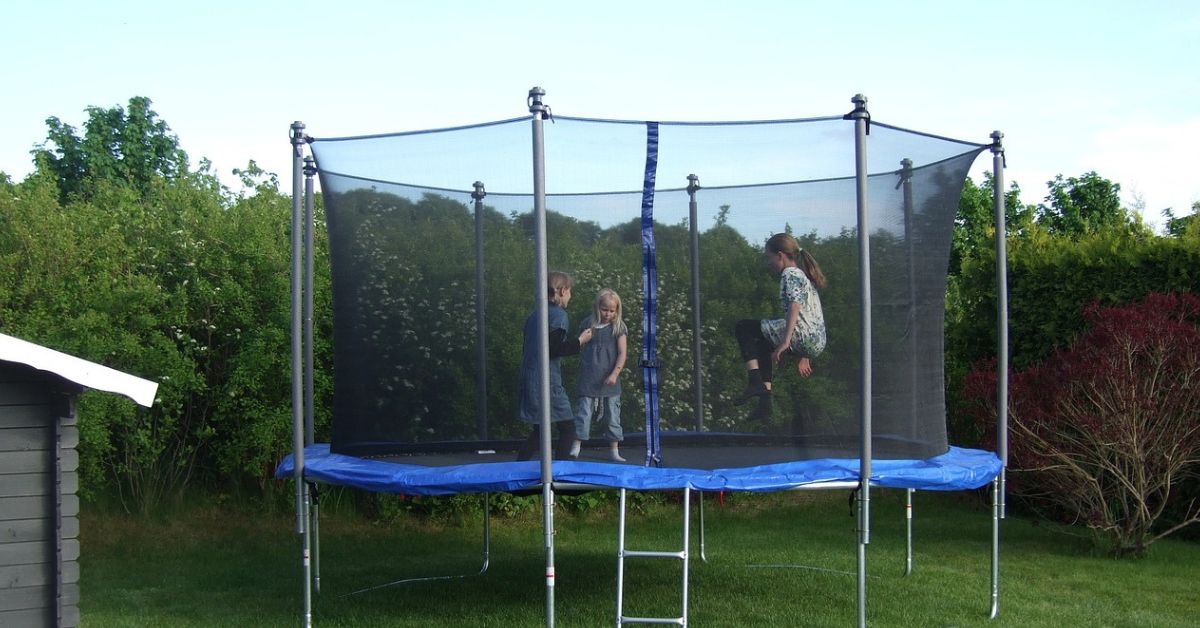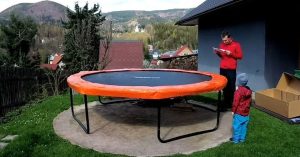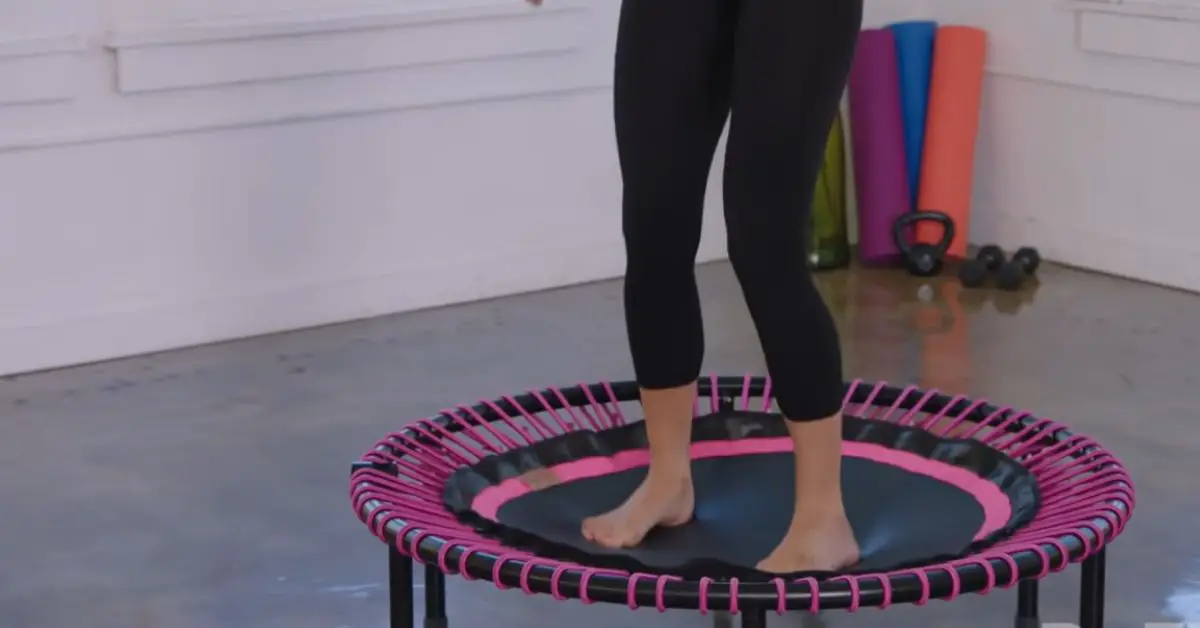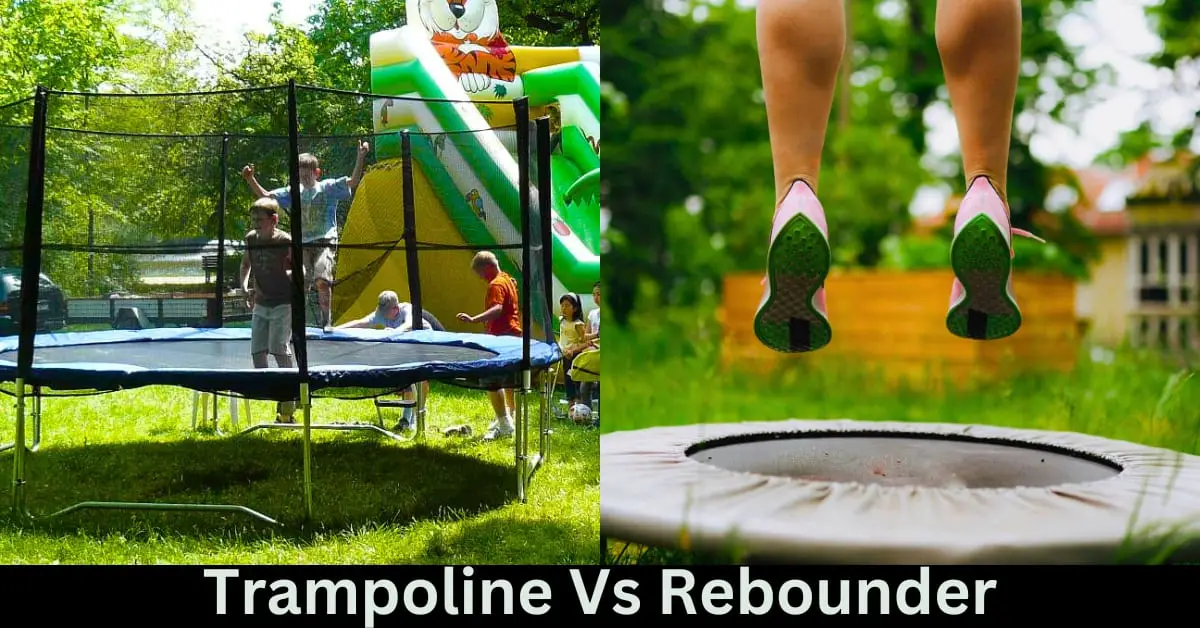When I compared Trampolines Vs Rebounders, it became clear that there are distinct differences between the two. I found that rebounders are smaller in size and specifically designed for indoor use. They are ideal for my solo exercise sessions and can support only one person at a time.
On the other hand, trampolines are mainly used outdoors and provide a recreational experience. They are larger in size and can accommodate multiple jumpers simultaneously. This makes trampolines great for social gatherings or family fun in the backyard.
So, while browsing platforms like Amazon, it’s essential to keep these differences in mind to choose the right option based on your specific needs and preferences.
Trampoline Vs Rebounder: Trampolines and rebounders differ in size and height. Rebounders are smaller, and lower to the ground, while trampolines are larger and elevated. Choose the right option based on your space and preference.
What is the Definition of a Trampoline?

A trampoline is a piece of equipment that you jump on for fun and exercise. It consists of a large, strong fabric stretched over a metal or steel frame, supported by springs. When you jump on the trampoline, the springs and fabric create a bouncing effect.
Trampolines are used for recreational purposes by both children and adults, providing a fun and energetic activity. They are also used by gymnasts, both amateur and professional, as a training tool to practice their skills before competitions.
Different Types of Trampolines:
Trampolines are available in various shapes and sizes. When thinking about the types of trampolines, people often associate them with shapes such as round or rectangular. However, there are other factors that define trampolines, as we will explore.
Rectangle Trampolines:
Rectangular trampolines are a popular choice among families, semi-professional gymnasts, and those who enjoy tricking and gymnastics practice. These trampolines are commonly used in Olympic trampoline gymnastics, offering an authentic and high-performance experience.
One of the advantages of a rectangular trampoline is its ability to provide a consistent bounce across the entire surface. The robust fabric used in these trampolines can handle heavier weights, allowing for higher jumps and better performance.
They are typically available in medium and large sizes, catering to the specific needs of gymnastics practice.
Acon is renowned for its innovation, performance, and superior bounce in rectangular trampolines. Whether you’re an aspiring gymnast or simply enjoy practicing tricks, a rectangular trampoline will offer the durability and responsiveness you need for a thrilling and safe experience.
Rounded Trampolines:

Round trampolines are the go-to option for families looking to bring the joy of bouncing into their backyard.
These recreational trampolines, available with or without safety nets, offer versatile entertainment for kids and adults alike.
With sizes ranging from eight to sixteen feet in diameter, round trampolines provide the best and highest bounce right at the center. Get ready to experience endless fun and laughter as you jump and soar on a round trampoline in your own backyard.
Exploring Alternative Shapes and Styles:
Square, oval, and hexagonal-shaped trampolines are less commonly found compared to round or rectangular ones, but they can still be found on the market. Round and rectangular trampolines are generally more popular.
While most trampolines are designed for above-ground use, there are also models specifically made for in-ground installation in gardens. Trampoline sizes, regardless of shape, can vary, with larger outdoor trampolines often used for gymnastics training and practice.
Pros and Cons: Trampoline
Here are some Pros and cons of trampolines:
Pros:
- A wide range of size options is available
- Long-lasting and well-designed models
- Provides recreational enjoyment for the entire family
- Enduring designs for long-term use
- Suitable for various types of jumping activities, including casual bouncing, gymnastics, and tricking
- Compatible with additional accessories like tents and basketball hoops
- High weight capacity or no weight limit
Cons:
- Primarily intended for outdoor use, unless there is sufficient indoor space with appropriate dimensions
- Can involve a significant cost or financial commitment
What is a Rebounder Trampoline?
A rebounder is a smaller trampoline used for indoor exercise and workouts. It is specifically designed to enhance your fitness routine. Unlike regular trampolines, a rebounder offers more resistance during bouncing, providing a targeted workout for your muscles.
With a rebounder, you can engage your muscles while enjoying the bouncing motion, making it an effective tool for fitness and muscle conditioning.
Types of Rebounder Trampolines:
Rebounder trampolines are lightweight and convenient to store at home, making them perfect for individual aerobic workouts that are gentle on the body due to their low-impact nature.
Rebounders are available in two main types: the basic format and the handlebar version. Now, let’s explore the distinctions between these two types.
Handlebar Rebounders:
Handlebar rebounders are similar to basic rebounders but feature a convenient handlebar. The handlebar adds flexibility and stability, enabling users to perform more complex and intense exercises.
Whether you’re bouncing or stretching on the rebounder, the handlebar provides extra support, helping you maintain balance and fully capitalize on the health benefits of a comprehensive workout.
With the added stability and versatility offered by the handlebar, you can maximize your fitness routine and achieve your fitness goals effectively.
Standard Rebounders:
A standard rebounder refers to the regular type, typically slightly smaller than mini trampolines. These rebounders are specifically designed for fitness purposes and are an excellent option for stretching and low-impact exercises.
The gravitational force exerted on the body while using a rebounder intensifies the impact of body weight, resulting in a more efficient workout. Instead of springs, basic rebounders feature durable and flexible bungee cords that provide protection and support to ligaments and joints.
The bounce experienced on a basic rebounder is deeper and more gentle, ensuring a comfortable and effective exercise session.
Pros and Cons: Rebounders

Here are some pros and cons of rebounders:
Pros:
- Easily portable, allowing for convenient transportation
- Specifically designed bounce for fitness purposes
- Low-impact exercises make it suitable for a wide range of individuals, being gentle on joints
- Offers a simple and enjoyable method of engaging in physical activity
Cons:
- Restricted to indoor use only
- Provides a lower bounce compared to traditional trampolines
Trampoline Vs Rebounder: Understanding the Difference
Trampolines and rebounders have a lot in common, but they also have their own unique qualities that you might prefer over the other. It’s important to note that one is not necessarily better than the other, they’re just different.
A Comparison of Shape and Color:
Similar to trampolines, rebounders are available in different shapes such as circles, rectangles, and even trapezoids. Additionally, they come in a variety of colors, allowing you to find one that matches your personal style and preferences.
Comparing Portability:
It’s evident that rebounders are significantly more portable than trampolines because of their smaller size and lighter weight.
Many rebounders even offer convenient foldable features, allowing you to fold down the legs or collapse the entire set for easy storage and transport.
On the other hand, trampolines lack this level of flexibility. Once you have set up a trampoline, it can be quite challenging to disassemble and pack it for relocation. Moreover, trampolines typically weigh around 200 pounds, making them much bulkier and harder to move around.
A Comparison of Size:
Distinguishing between a rebounder and a trampoline is important to understand their differences.
A rebounder is essentially a smaller version of a trampoline, often used for fitness and weight loss purposes. It is typically used indoors and is designed to be easily installed, disassembled, transported, and stored.
Rebounders, also known as fitness or mini-trampolines, have a smaller bounce compared to most trampolines. Outdoor trampolines are usually between 7-1/2 and 16 feet in size (or even larger for commercial use), while rebounders are typically around 3-1/2 feet in diameter.
Related article: Best size trampoline for family
Comparing Weight Capacity:
Interestingly, certain rebounders have a weight capacity of up to 400 pounds, varying depending on the brand and model. In comparison, standard trampolines typically support weights ranging from 100 pounds for smaller models to 330 pounds for larger models.
However, there are exceptions, as certain trampolines like Magic Cage/Circle and rebounders like The Bellicon can handle even higher weight capacities.
It’s important to note that both trampolines and rebounders are designed for one person to jump on at a time.
Comparing Health Benefits:
Both rebounders and trampolines offer benefits for improving overall muscle coordination, making them particularly helpful for individuals dealing with back or joint pain.
Fitness trampolines are ideal if you want to incorporate walking, jogging, or bouncing into your workout routine. Some fitness trampolines even come with a workout video that guides you through different exercise routines.
Outdoor trampolines, on the other hand, promote playful activities. These larger trampolines often have additional accessories available for purchase, such as basketball sets, tent attachments, and bounce boards.
Unlike most rebounders, some outdoor trampolines also feature a safety net, making them a fantastic choice for families with young children.
Comparing Safety:
Rebounders, used for indoor exercises, have a lower bounce than trampolines and are positioned closer to the ground, reducing the risk of falling from heights.
Adding soft pads or rugs around a rebounder can provide a cushioned surface for step-offs, minimizing the impact on knees and joints. Some rebounders also offer stability bars, which can be helpful for beginners and older individuals who prefer to hold onto something for balance.
While opinions vary among experts, rebounding can be a safe workout option for pregnant women, particularly during the first trimester.
Trampolines have gained a negative reputation due to the number of accidents and visits to the emergency room. Jumping on trampolines can indeed be risky if proper safety precautions are not taken.
It is crucial to closely supervise children and establish clear rules for trampoline play to ensure their safety. Additional safety measures can be implemented by using a safety enclosure and securely anchoring the trampoline.
Comparing Usage:
Both trampolines and rebounders are beneficial for improving overall muscle coordination, particularly for individuals with back or joint pain.
If you enjoy incorporating walking, jogging, or bouncing into your workout routine, fitness trampolines are a great choice. Some fitness trampolines even come with workout videos that provide a variety of exercise options. You can also find numerous workout videos on platforms like YouTube.
Outdoor trampolines, on the other hand, encourage physical activity and playtime. These larger trampolines often offer additional accessories for purchase, such as basketball sets, tent attachments, and bounce boards.
Unlike rebounders, some trampolines include a safety net, making them an excellent option for families with young children. Additionally, trampolines provide the opportunity for more adventurous individuals to try out various exciting trampoline tricks that are not possible with a rebounder.
Comparing Prices:
The cost of a rebounder can vary depending on the brand and model, typically ranging from around $30 to $200. However, there are higher-end models available in the $700 price range.
Outdoor trampolines, on the other hand, generally fall within the price range of $100 to $400, with some higher-end options reaching around $1,000.
Which Option Is the Most Suitable for You?
Choosing between a trampoline and a rebounder depends on factors such as who will be using it, how it will be used, and where it will be used.
Consider the Purpose:
- If you want to jump for fun and recreation, a traditional or outdoor trampoline is recommended.
- For fitness activities like walking, jumping, or bouncing, a rebounder is a better choice.
Think About the Users:
- Rebounders are suitable for all ages, including the elderly, and can provide a beneficial workout for those with knee or back problems.
- Trampolines are great for families with children. Round trampolines are particularly suitable for younger children, as they offer a softer and more even bounce. Larger trampolines are ideal if you want equipment that can accommodate growing kids.
Consider the Space:
- If you have limited space, a rebounder is a convenient option. It works well in apartments or small yards and eliminates the need for frequent setup and takedown.
- For larger spaces, a standard trampoline is a good choice, offering enjoyment for the entire family.
Remember Quality and Weight Support:
- Regardless of your choice, ensure that the equipment is of high quality and can support your weight and the weight of other users.
By considering these factors, you can find the option that best suits your needs and preferences.
Consider the Available Space
It’s important to acknowledge that not everyone has a backyard or enough space to fit a trampoline comfortably.
Even a small trampoline measuring 8 feet in diameter requires a significant amount of space, as you need to ensure there is enough clearance for safety purposes.
Additionally, you have to make sure there are no overhanging objects, such as tree branches, that could obstruct the trampoline.
On the other hand, a rebounder requires much less space. All you need is about 3-4 feet of clearance, making it a more suitable option for smaller areas or indoor use.
Maintenance and Longevity
Maintaining and ensuring the longevity of your exercise equipment is crucial for maximizing its benefits and investment. Both trampolines and rebounders require proper care to ensure safe and effective use over time.
Here’s a comparison of maintenance and longevity considerations for trampolines and rebounders:
Trampolines:
Here are the considerations for trampoline:
Inspection and Maintenance:
- Regularly inspect the trampoline frame, springs, and mat for signs of wear and tear, rust, or damage.
- Check the enclosure netting, poles, and padding to ensure they are intact and secure.
- Tighten any loose bolts or components and replace damaged parts promptly.
Weather Protection:
- If your trampoline is set up outdoors, consider investing in weather-resistant covers to protect it from the elements when not in use.
- During harsh weather conditions, such as storms or heavy snowfall, disassemble and store the trampoline to prevent damage.
Cleaning:
- Clean the trampoline mat and padding regularly to remove dirt, debris, and sweat.
- Use mild soap and water to clean the mat and wipe down the frame and other components.
Seasonal Storage:
- During the off-season, disassemble and store the trampoline in a dry and sheltered area to prevent rust and deterioration.
Weight Limits and Proper Usage:
- Adhere to the recommended weight limits to prevent excessive strain on the springs and frame.
- Educate users about proper jumping techniques to reduce wear on the mat and springs.
Rebounders:
Here are the considerations for rebounders:
Inspection and Maintenance:
- Check the frame, springs (if applicable), and mat for any signs of damage or wear.
- Ensure that the frame is stable and secure before each use.
Cleaning:
- Wipe down the mat and frame regularly to prevent the buildup of sweat and dirt.
- Use a mild cleaning solution and a soft cloth to clean the rebounder.
Storage:
- Rebounders are often compact and portable, making them easy to store indoors when not in use.
Tension and Stability:
- If your rebounder has adjustable tension bands or springs, check and adjust them as needed to maintain the desired bounce.
Proper Footwear and Attire:
- Encourage users to wear appropriate athletic shoes while using the rebounder to prevent excessive wear on the mat.
Longevity Considerations:
- Trampolines: Proper maintenance, regular inspections, and adherence to weight limits can extend the life of a trampoline. However, exposure to weather elements and potential wear on components may require more vigilant care.
- Rebounders: Rebounders generally have a simpler design and fewer moving parts, which can contribute to their longevity. Regular inspections and appropriate usage can help keep them in good condition.
FAQs:
Q:1 Is a rebounder superior to a trampoline in terms of benefits?
Rebounders are compact fitness trampolines specifically designed to elevate your indoor workouts and exercise routines. Unlike regular trampolines found in gardens, rebounders provide a unique bouncing experience with increased resistance.
This resistance helps intensify your workouts and makes rebounding a highly effective form of exercise.
Q:2 What are the drawbacks of rebounding?
Rebounding may not be suitable for individuals diagnosed with pinched nerves, osteoporosis, or sciatica. The powerful forces generated during rebounding can put a strain on the spine, causing compression and increased pressure on the discs.
Over time, this can lead to joint stretching and potential discomfort. It’s important for individuals with these conditions to consult with their healthcare providers before engaging in rebounding activities to ensure it is safe and appropriate for their specific condition.
Q:3 What is the equivalent of 20 minutes of rebounding in terms of exercise?
Fortunately, according to NASA, trampolining is considered 68 percent more effective than running. Additionally, fitness company Frame, known for its popular Rebounding classes, states that just 20 minutes of bouncing on a trampoline is equivalent to an hour of running.
This makes trampolining a time-efficient and highly effective form of exercise for those looking to maximize their workouts and achieve great results.
Q:4 What is the equivalent of 10 minutes of rebounding in terms of exercise?
According to a study conducted by NASA, it was discovered that 10 minutes of jumping on a trampoline is equivalent to a 30-minute run. This means that exercising on a trampoline requires less time compared to running while still providing similar benefits.
This finding highlights the efficiency and effectiveness of trampoline workouts, making them a time-saving option for those looking to stay fit and active.
Q:5 Is 10 minutes of rebounding per day sufficient?
Once you have progressed beyond the beginner stage of rebounding, we suggest engaging in two 10-minute rebounding sessions per day. According to NASA, a 20-minute rebounding session can be just as effective as a 30-minute jog.
This highlights the efficiency of rebounding workouts, allowing you to achieve comparable benefits in a shorter amount of time. By incorporating regular rebounding sessions into your daily routine, you can reap the rewards of this low-impact and effective form of exercise.
Conclusion:
In conclusion, when comparing trampolines and rebounders, it becomes evident that they serve different purposes and cater to specific needs. Trampolines are typically larger in size, elevated off the ground, and designed for outdoor recreational activities.
They offer ample space for multiple jumpers to enjoy bouncing and performing acrobatic maneuvers. Trampolines provide a fun and social experience, making them a popular choice for families and outdoor gatherings.
On the other hand, rebounders are smaller and lower to the ground. They are primarily used for indoor exercise and fitness routines.
With a narrower diameter and lower elevation, rebounders are suitable for solo workouts, providing a low-impact and efficient way to improve cardiovascular health, balance, and overall fitness. They are compact, making them ideal for indoor spaces with limited room.
Ultimately, the choice between a trampoline and a rebounder depends on personal preferences, available space, and intended use.
Whether you seek outdoor fun and entertainment or a convenient indoor exercise option, understanding the differences between trampolines and rebounders will help you make an informed decision that suits your specific needs and lifestyle.
We hope you will be well aware of trampoline vs Rebounder, after reading this comprehensive article. If you have any questions, feel free to comment below!

